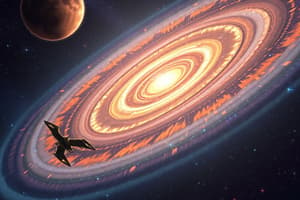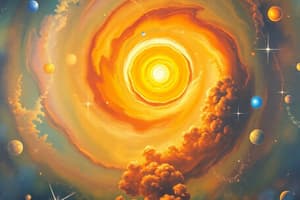Podcast
Questions and Answers
What is an astronomical unit (AU)?
What is an astronomical unit (AU)?
- The distance from the Earth to the Sun. (correct)
- The distance from the Earth to the Moon.
- The distance between two galaxies.
- The distance light travels in one year.
Why do astronomers use light-years as a measurement?
Why do astronomers use light-years as a measurement?
- To measure the size of planets.
- To measure distances between stars and galaxies. (correct)
- To measure distances within the Solar System.
- To measure the temperature of stars.
How far is Alpha Centauri from the Sun in kilometers?
How far is Alpha Centauri from the Sun in kilometers?
- 1.58 trillion kilometers. (correct)
- 4.2 billion kilometers.
- 4.2 million kilometers.
- 40.2 billion kilometers.
What are the inner planets known for?
What are the inner planets known for?
What is the primary composition of the Sun?
What is the primary composition of the Sun?
What is true about the outer planets?
What is true about the outer planets?
Which of the following is a characteristic of Mercury?
Which of the following is a characteristic of Mercury?
How long ago was the Solar System formed?
How long ago was the Solar System formed?
What distinguishes satellites from other celestial bodies?
What distinguishes satellites from other celestial bodies?
Which of the following statements about dwarf planets is accurate?
Which of the following statements about dwarf planets is accurate?
What is a key characteristic of asteroids?
What is a key characteristic of asteroids?
Comets have a unique feature when they approach the Sun. What is it?
Comets have a unique feature when they approach the Sun. What is it?
Which celestial body is NOT part of the Solar System but exists in outer space?
Which celestial body is NOT part of the Solar System but exists in outer space?
What is the main component of the Earth's atmosphere that supports life?
What is the main component of the Earth's atmosphere that supports life?
What is the primary composition of a comet's nucleus?
What is the primary composition of a comet's nucleus?
Asteroids found between Mars and Jupiter are part of which structure?
Asteroids found between Mars and Jupiter are part of which structure?
What is the temperature on Earth's surface approximately due to its distance from the Sun?
What is the temperature on Earth's surface approximately due to its distance from the Sun?
Which element of Earth's atmosphere is crucial for supporting life?
Which element of Earth's atmosphere is crucial for supporting life?
Which of the following characteristics contributes to Earth being habitable?
Which of the following characteristics contributes to Earth being habitable?
What is the primary function of Earth's magnetic field?
What is the primary function of Earth's magnetic field?
How long does it take for Earth to complete one rotation on its axis?
How long does it take for Earth to complete one rotation on its axis?
What are the characteristics of the Earth’s orbit around the Sun?
What are the characteristics of the Earth’s orbit around the Sun?
What is the tilt angle of the Earth's rotational axis?
What is the tilt angle of the Earth's rotational axis?
What role does the Moon play in relation to Earth?
What role does the Moon play in relation to Earth?
What does the geocentric theory propose about the structure of the Universe?
What does the geocentric theory propose about the structure of the Universe?
Which of the following statements best describes the heliocentric theory?
Which of the following statements best describes the heliocentric theory?
What major misconception is emphasized in the content regarding the structure of the Universe?
What major misconception is emphasized in the content regarding the structure of the Universe?
Which components are included in the Solar System according to the content?
Which components are included in the Solar System according to the content?
What are the primary causes of the seasons?
What are the primary causes of the seasons?
During which phenomenon does the Moon come between the Earth and the Sun?
During which phenomenon does the Moon come between the Earth and the Sun?
What role does the Moon play in relation to the Earth as described in the unit objectives?
What role does the Moon play in relation to the Earth as described in the unit objectives?
Which of the following best describes the ancient Greeks' contribution to the understanding of the Universe?
Which of the following best describes the ancient Greeks' contribution to the understanding of the Universe?
What occurs during a New Moon phase?
What occurs during a New Moon phase?
What is a spring tide?
What is a spring tide?
How many high tides occur at a single location in a 24-hour period?
How many high tides occur at a single location in a 24-hour period?
Which phase of the Moon has the Moon appearing D-shaped?
Which phase of the Moon has the Moon appearing D-shaped?
What happens to the tides during neap tide?
What happens to the tides during neap tide?
What defines a solar eclipse?
What defines a solar eclipse?
Why is it that we always see the same side of the Moon from Earth?
Why is it that we always see the same side of the Moon from Earth?
What causes the rising and falling of sea levels known as tides?
What causes the rising and falling of sea levels known as tides?
Study Notes
The Universe: Early Ideas and Components
- Ancient Greek geocentric theory: Earth at the center, celestial bodies revolve around it. Ptolemy later refined this model.
- Heliocentric theory (Copernicus, 1543): Sun at the center, Earth and other planets revolve around it. The Moon revolves around the Earth.
- Modern understanding refutes both: Neither the Earth nor the Sun is at the Universe's center.
Measuring the Universe
- Astronomical Unit (AU): Earth-Sun distance (~150 million km), used for Solar System measurements.
- Light-year: Distance light travels in one year ( ~9.461 × 1012 km), used for interstellar and intergalactic distances.
The Solar System
- Formed approximately 4.5 billion years ago from a collapsing nebula.
- Components: Sun, eight planets, dwarf planets, asteroids, and comets.
The Sun
- Yellowish, medium-sized star.
- Composed primarily of hydrogen and helium.
- Nuclear reactions in its core produce immense energy, light, and heat.
Planets: Inner vs. Outer
- Inner (Terrestrial/Rocky): Mercury, Venus, Earth, Mars. Small, rocky composition, relatively thin atmospheres. Earth has one satellite, Mars has two, Mercury and Venus have none.
- Outer (Gas Giants): Jupiter, Saturn, Uranus, Neptune. Large, gaseous composition with small cores, thick atmospheres, and numerous satellites.
Other Celestial Bodies
- Satellites: Orbit planets; vary in size and shape (e.g., Moon).
- Dwarf planets: Small, round, haven't cleared their orbital path (e.g., Pluto, Ceres).
- Asteroids: Irregular-shaped rocky bodies; some form asteroid belts (between Mars and Jupiter; beyond Neptune's orbit) .
- Comets: Small, irregular bodies with icy, dusty nuclei; highly elliptical orbits, originating from the Oort Cloud. Develop tails when approaching the Sun.
Planet Earth: Unique Characteristics
- Atmosphere with oxygen (O2) and carbon dioxide (CO2), essential for life.
- Surface temperature around 15°C due to distance from the Sun and atmospheric composition.
- Water exists in all three phases (ice, liquid, vapor), enabling the water cycle.
- Magnetic field shields the surface from harmful solar radiation.
- Large satellite (Moon) influences tides.
- Active geology (volcanoes, earthquakes).
Earth's Movements
- Rotation: West to East (anti-clockwise), 24 hours (day), causes day-night cycle. Earth's axis is tilted at ~23.5°.
- Revolution: Around the Sun, 365.25 days (year), causes seasons due to the tilt of the rotational axis. Orbit is elliptical, hence varying Earth-Sun distances (aphelion: furthest, perihelion: nearest).
The Moon: Phases and Tides
- Phases: New Moon (not visible), First Quarter (D-shaped), Full Moon (fully illuminated), Last Quarter (C-shaped).
- Tides: Periodic sea-level changes due to Moon and Sun's gravitational pull. Two high tides and two low tides per day (every 12 hours). Spring tides (highest) occur when Earth, Sun, and Moon are aligned. Neap tides (lowest) occur when the alignment is at a 90° angle.
Eclipses
- Solar eclipse: Moon blocks sunlight from reaching Earth, casting a shadow.
- Lunar eclipse: Earth blocks sunlight from reaching the Moon, casting a shadow.
Studying That Suits You
Use AI to generate personalized quizzes and flashcards to suit your learning preferences.
Related Documents
Description
Explore the historical and modern concepts of the universe, from ancient geocentric and heliocentric theories to current understandings. Learn about essential measurements like astronomical units and light-years, as well as the formation and components of the Solar System.




